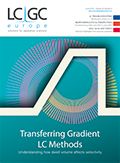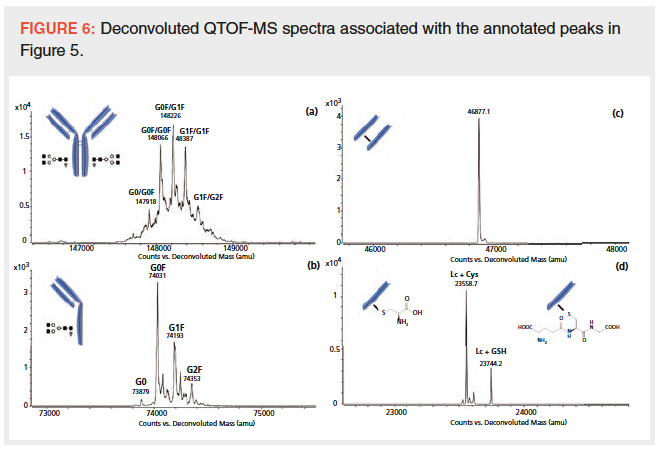Mixing and Mixers in Liquid Chromatography, Part 3: Solutions for Problems with Sample Diluents
LCGC Europe
Adding an inline mixer between the sample injector and column in a liquid chromatography (LC) system can be an effective way to resolve problems with peak shape caused by the sample diluent.
Adding an inline mixer between the sample injector and column in a liquid chromatography (LC) system can be an effective way to resolve problems with peak shape caused by the sample diluent.
In two recent instalments of “LC Troubleshooting”, I discussed the roles of mixers in liquid chromatography (LC) systems in a general sense (1,2). Mixers are often used in pumping systems to smooth out short-term irregularities in mobile phase composition. They are used less frequently between the sample injection point and the LC column, but doing so can be remarkably useful, helping to alleviate some problems caused by mismatch between the properties of the sample diluent and the mobile phase the sample is injected into. This month, I have asked AbbVie scientists Zach Breitbach, Corianne Randstrom, Jean Chang, Michael Lesslie, and Gregory Webster to join me in discussing some of their results that illustrate the utility of mixers in practice. By way of several examples, we first show the poor peak shapes that can result from sample and mobile phase mismatch, and then show how inline mixers can be used to resolve this problem and produce much better analytical results.
Dwight Stoll
Review from Last Time: Effect of Diluent and Eluent Mismatch on Peak Shape

In January of this year, we wrote about how diluent and eluent mismatch can negatively affect separations, especially when the injection volume is a significant fraction (more than about 1%) of the column dead volume (3). This can be observed for all types of separations, but in January we focused this effect for hydrophilic interaction liquid chromatography (HILIC) separations because it seems this is not widely appreciated in the separations community. A subset of these results is shown in Figure 1, where we compare the chromatograms obtained for a simple two-component mixture of cytidine and guanosine under HILIC conditions. In this case, the injection volume of 20 µL is about 20% of the column volume, and terrible chromatography is observed if the sample diluent is 100% water (Figure 1[a]). The peaks are not just split; a significant fraction of the mass of both compounds breaks through and elutes at the dead time of the column. Further, some drug product (DP) extractions require a particular pH or stronger diluents, and some targeted impurities may not be amenable to dilution with weak solvent following extraction because this makes it difficult to reach the detection limits required for trace analysis. In the example shown in Figure 1, we can easily resolve the problem by simply changing the diluent to 95:5 acetonitrile–water. This yields the chromatogram shown in Figure 1(b), where the peaks are entirely respectable and well separated, with no sample breakthrough observed.
In this example, we can resolve the diluent and eluent mismatch problem by simply changing the diluent to more closely resemble the eluent. In some applications, however, this is not a viable solution because of the low solubility of some sample components in diluents that resemble the eluent (in the case of gradient elution, the initial eluent used in the gradient). In these cases, attempting to dilute the sample with eluent prior to injection can result in precipitation of sample components, which in turn can lead to poor analyte recovery and plugging of LC components and columns. It is in these situations that adding an inline mixer between the sample injection point and the column can be a relatively simple and effective solution to the diluent and eluent mismatch problem. In the following examples, we show the benefit of this approach in the context of real applications.
Adding an Inline Mixer
As discussed last year in “LC Troubleshooting” (1,2), mixers are commonly used in LC pumping systems to smooth out short-term variations in eluent composition that result from nonideal pump behaviour. The position of mixers used for this purpose relative to the high-pressure pump and sample injector is shown in Figure 2. When we refer to an inline mixer in this article, we are referring to the placement of a mixer between the sample injector and the LC column, shown in Figure 2 as “Mixer-2”. Although using an inline mixer is not common practice, adding an inline mixer to an LC setup is straightforward. Some commercially available mixers are based on sophisticated fluidic designs that have been optimized for mixing efficiency. Some mixing can also be achieved by simply adding a piece of larger than normal tubing between the injector and the column (for example, 0.010–0.020-in. internal diameter [i.d.] tubing). Of course, these different approaches to mixing have advantages and disadvantages, and these should be considered carefully during method development.

Example #1: Fixing Peak Shape for a Hydrophilic API Impurity: It is common to encounter impurities related to an active pharmaceutical ingredient (API) that are much more hydrophilic (water soluble) than the API itself. This type of situation presents a challenge during method development because API or drug product samples assayed for impurities contain compounds with a wide range of water solubilities or pKa values, and require rather nonpolar diluents with pH values that may differ significantly from that of the mobile phase. Figure 3 shows a series of chromatograms focused on the peak shape of a hydrophilic impurity that elutes early in a reversedâphase gradient elution method. Figure 3(a) shows the peak observed with a conventional LC setup, with the injector connected directly to the column with no inline mixer installed. The peak shape in this case does not appear to be that bad at first glance, with just a slight “foot” on the front of the peak. However, the chromatograms obtained when adding mixers of different volumes between the injector and column (Figures 3[b]–3[d]) show that the result with no mixer is far worse than was immediately evident. Adding the 25, 50, and 100 µL mixers adds significantly to the area on the front side of the peak. This reveals the fact that when no mixer is used, the peak splits so severely that a significant fraction of the analyte mass elutes at the dead time. This is more easily understood by plotting the apparent mass recovery of this analyte as a function of injection volume, where recovery is calculated using the area of the peak eluting at about 3.3 min. In other words, the area under the peak eluting at the dead time is not considered in this calculation. This plot is shown in Figure 4. Here we see that, when the injection volume is small, the recovery is high because under these conditions the peak does not split, and all of the mass is accounted for by the peak at 3.3 min. However, as the injection volume is increased, larger mixers are required to prevent peak splitting and maintain ~100% recovery. Although the peak in the case of the 100 µL mixer is broader than we would like, this is a consequence of the relatively large injection volume and the hydrophilic nature of the impurity. Here, it is more important to obtain good recovery of the analyte than it is to have a narrow peak because this impurity is well separated from the rest of the mixture. Finally, Figure 5 shows that the addition of the inline mixer does not have significant negative impacts on the characteristics (peak width and shape) of the peaks eluting later in the chromatogram.



Example #2: Fixing Peak Shape for Laurylglycol in Tetrahydrofuran Diluent: The challenge illustrated by the previous example arises from the low retention of a very hydrophilic compound under reversed-phase conditions. However, we can encounter similar problems, even for relatively hydrophobic compounds, if the mismatch between the properties of the sample diluent and eluent is large enough. Figure 6 shows chromatograms obtained from separations of a mixture of Tween (polysorbate) and lauryl glycol ether in a sample diluent of 100% tetrahydrofuran, with either no mixer (Figure 6[a]) or a 25 µL inline mixer installed (Figure 6[b]). Under the conditions of the experiment, the lauryl glycol is eluted from the reversedâphase column in 100% acetonitrile. And yet, in spite of the high reversed-phase retention of this compound, we still observe a small shoulder on the front of the peak in the case where no mixer is used. This results from the same type of effect illustrated in Figure 1 (for HILIC conditions) and Figures 3–5 because the tetrahydrofuran sample diluent is a very strong solvent for reversedâphase columns. The good news here is that the problem is easily resolved in this case through the addition of a low-volume mixer. Because the lauryl glycol is pretty “sticky” under reversed-phase conditions, it only takes a modest modulation of the tetrahydrofuran level as the sample plug travels through the column to produce a big effect on retention of the analyte, and, in turn, the improvement of peak shape by eliminating the shoulder on the front of the peak.

Summary
In this instalment of “LC Troubleshooting”, we have shown, by way of examples from real small molecule pharmaceutical analysis, how implementation of an inline mixer in an LC system between the sample injection point and the analytical column can be useful for fixing poor peak shapes that result from mismatch between sample diluent and mobile phase. In serious cases of this mismatch, peak distortion can be so bad that some of the analyte elutes at the column dead time, leading to apparently low mass recoveries. In these cases, adding the inline mixer may not only improve peak shape, but also mass recovery. Finally, we have shown that the volume of the mixer itself affects the extent to which this approach mitigates the diluent and mobile phase mismatch problem, and thus users are advised to determine by experiment which mixer volume will be most appropriate for their application.
References
- D.R. Stoll, LCGC Europe31(10), 558–563 (2018).
- D.R. Stoll, LCGC Europe31(11), 608–613 (2018).
- D.R. Stoll, LCGC Europe32(1), 16–20 (2019).
Zachary Breitbach is a senior scientist in the Analytical Research and Development department of AbbVie, in North Chicago, Illinois, USA.
Corriane Randstrom is a scientist in the Analytical Research and Development department of AbbVie, in North Chicago, Illinois.
Jean Chang is a chemist in the Analytical Research and Development department of AbbVie, in North Chicago, Illinois.
Michael Lesslie is a senior scientist in the Analytical Research and Development department of AbbVie, in North Chicago, Illinois.
Gregory Webster is a senior principal research chemist in the Analytical Research and Development department of AbbVie, in North Chicago, Illinois.
Dwight R. Stoll is the editor of “LC Troubleshooting”. Stoll is a professor and co-chair of chemistry at Gustavus Adolphus College in St. Peter, Minnesota, USA. His primary research focus is on the development of 2D-LC for both targeted and untargeted analyses. He has 60 publications and four book chapters in separation science and more than 100 conference presentations. He is also a member of LCGC’s editorial advisory board. Direct correspondence to: LCGCedit@mmhgroup.com

Regulatory Deadlines and Supply Chain Challenges Take Center Stage in Nitrosamine Discussion
April 10th 2025During an LCGC International peer exchange, Aloka Srinivasan, Mayank Bhanti, and Amber Burch discussed the regulatory deadlines and supply chain challenges that come with nitrosamine analysis.
















